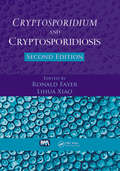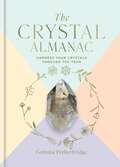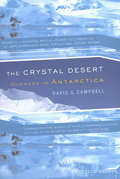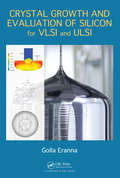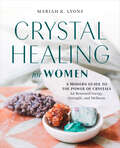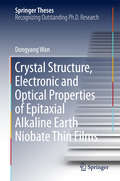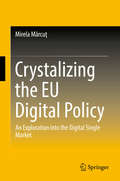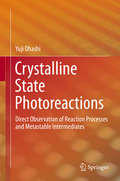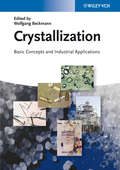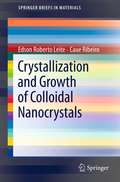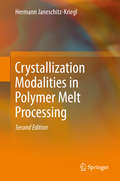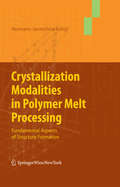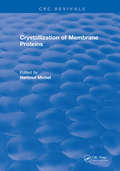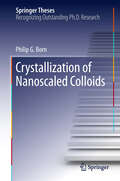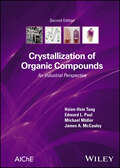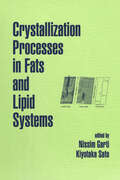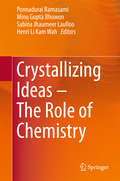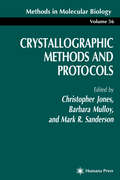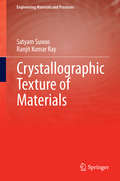- Table View
- List View
Cryptosporidium and Cryptosporidiosis
by Ronald Fayer Lihua XiaoFrom the microscopic observation of infection to the widespread application of molecular techniques in taxonomy and epidemiology, to the genome sequencing of two major species and advances in biochemistry, phylogeny, and water treatment, new information on this fascinating genus continues to mount as we discover and utilize the latest scientific te
The Crystal Almanac: Harness Your Crystals Through the Year
by Gemma PetherbridgeEmbrace the energy of crystals throughout the changing seasonsThroughout the year, the energies around us vary dramatically. Working with crystals is all about bringing specific energies into our life, so it's important to be connected with these natural cycles, to ensure we're bringing balance, peace and healing into our lives in our crystal work.In The Crystal Almanac, certified Crystal Healer Gemma Petherbridge teaches you how the seasons might feel or play out, the emotional shifts that can happen throughout the year, and how changing energies can affect our mood, happiness and even our manifestation skills. Discover the Sabbats and celebrations, moon phases, astrological cycles and deities related to each season and learn how you can use this knowledge to support and enhance your crystal work. Featuring crystal activities tailored to every month, this book will help to bring you into alignment with the natural world.For each month you will discover:-A crystal to help you work with the elemental energies or an upcoming Sabbat celebration-A crystal to correspond with that month's astrological/lunar changes-A crystal that will allow you to call in a goddess and tap into her power-A crystal to summarise the month's overall themes and energies-Two activities to help you put your crystal work into practice
The Crystal Almanac: Harness Your Crystals Through the Year
by Gemma PetherbridgeEmbrace the energy of crystals throughout the changing seasonsThroughout the year, the energies around us vary dramatically. Working with crystals is all about bringing specific energies into our life, so it's important to be connected with these natural cycles, to ensure we're bringing balance, peace and healing into our lives in our crystal work.In The Crystal Almanac, certified Crystal Healer Gemma Petherbridge teaches you how the seasons might feel or play out, the emotional shifts that can happen throughout the year, and how changing energies can affect our mood, happiness and even our manifestation skills. Discover the Sabbats and celebrations, moon phases, astrological cycles and deities related to each season and learn how you can use this knowledge to support and enhance your crystal work. Featuring crystal activities tailored to every month, this book will help to bring you into alignment with the natural world.For each month you will discover:-A crystal to help you work with the elemental energies or an upcoming Sabbat celebration-A crystal to correspond with that month's astrological/lunar changes-A crystal that will allow you to call in a goddess and tap into her power-A crystal to summarise the month's overall themes and energies-Two activities to help you put your crystal work into practice
The Crystal Desert: Summers in Antarctica
by David G. CampbellThe acclaimed author and biologist shares “a superb personal account [of Antarctica] . . . a remarkable evocation of a land at the bottom of the world” (Boston Globe).During the 1980s, biologist David Campbell spent three summers in Antarctica, researching its surprisingly plentiful wildlife. In The Crystal Desert, he combines travelogue, nature writing and science history to tell the story of life's tenacity on the coldest of Earth's continents. Between scuba expeditions in Admiralty Bay, Campbell remembers the explorers who discovered Antarctica, the whalers and sealers who despoiled it, and the scientists who laid the groundwork to decipher its mysteries. Chronicling the desperately short summers in beautiful, lucid prose, he presents a fascinating portrait of the evolution of life in Antarctica and of the continent itself.Winner of the John Burroughs Medal for Natural History Writing and a Houghton Mifflin Literary Fellowship
Crystal Fire: The Invention of the Transistor and the Birth of the Information Age (Sloan Technology Series)
by Michael Riordan Lillian Hoddeson"With impeccable scholarship and meticulous research, this book covers an impressive sweep of history from the discovery of the electron to the first integrated circuit. ... A definitive account of the birth of the semiconductor industry." -London Daily Telegraph "In rich detail, Riordan and Hoddeson unfurl the development of the transistor and the lives of its three principal discoverers- John Bardeen, Walter Brattain, and William Shockley. . . . Standing on the shoulders of giants while harvesting the fruits of their own astonishing research, the triumvirate of the transistor created the device that has revolutionized life today, making possible television, computers, and other electronic devices." -Library Journal
Crystal Growth and Evaluation of Silicon for VLSI and ULSI
by Golla ErannaSilicon, as a single-crystal semiconductor, has sparked a revolution in the field of electronics and touched nearly every field of science and technology. Though available abundantly as silica and in various other forms in nature, silicon is difficult to separate from its chemical compounds because of its reactivity. As a solid, silicon is chemical
Crystal Healing for Women: A Modern Guide to the Power of Crystals for Renewed Energy, Strength, and Wellness
by Mariah K. LyonsCrystal Healing for WomenA Modern Guide to the Power of Crystals for Renewed Energy, Strength, and WellnessDiscover the physical, mental, and spiritual healing power of crystals and awaken the healer within. Believed to hold restorative powers over our health, crystals have served humanity for millennia. With Crystal Healing for Women, you can unlock the ancient secrets of healing and wisdom held within these stones. Crystal healer and Reiki Master Mariah K. Lyons shares her knowledge in this beautifully-illustrated, practical guide that helps women awaken to their feminine divinity and healing powers, and rekindle their instinctual relationship with nature. She also shows you how to select and care for crystals and incorporate them in rituals. You'll learn to intentionally utilize crystals, helping you to find deeper levels of spiritual growth, integrated healing, and sustainable well-being. Crystal Healing for Women features: • Crystal healing fundamentals: How crystal vibrational energy works as well as how to activate, charge, and cleanse your crystals. • 40 energetic self-care rituals: Daily and seasonal wellness practices plus focused healing and manifestation for fertility, pregnancy, the feminine cycle, anxiety, creativity, and love. • 50 healing crystal profiles: Modern interpretations, individual features, and beautiful photographs of stones with energetic properties and healing compatibilities. • 10 key crystals for women: An in-depth look at select stones chosen for their potency, healing power, and connection to Divine Feminine energy. • Crystals in everyday life: Where to place them in your home and on your body and how to work with them and create crystal-healing grids.
Crystal Optics: Properties and Applications
by Ashim Kumar BainReviews the properties and applications of photo-elastic, acousto-optic, magneto-optic, electro-optic, and photorefractive materials This book deals with the basic physical properties and applications of photo-elastic, acousto-optic, magneto-optic, electro-optic, and photorefractive materials. It also provides up-to-date information on the design and applications of various optoelectronic devices based on these materials. The first chapter of Crystal Optics: Properties and Applications covers the basic concepts of crystal optics, such as index ellipsoid or optical indicatrix, crystal symmetry, wave surface, birefringence, and the polarization of light. Chapter 2 reviews the physical phenomena of crystal optics in isotropic and crystalline materials. It describes in detail research information on modern photoelastic materials and reviews the up-to-date photoelastic device applications. Chapter 3 develops the underlying theory of acousto-optics from first principles, formulating results suitable for subsequent calculations and design. The fourth chapter describes the basic principles of magneto-optic effects and mode of interaction with magnetic materials. The fifth chapter provides an understanding of the physical phenomenon of the linear and quadratic electro-optic effects in isotropic and crystalline materials. The last chapter collects many of the most important recent developments in photorefractive effects and materials, and pays special attention to recent scientific findings and advances on photorefractive materials and devices. -Features up to date information on the design and applications of various optoelectronic devices -Looks at the basic concepts of crystal optics, including the polarization of light, effects of reflection and transmission of polarization and light polarizing devices, and more -Pays special attention to design procedures for the entire range of acousto-optic devices and various applications of these devices -Provides research information on modern magneto-optic materials and reviews the up-to-date magneto-optic device applications?up to terahertz (THz) regime Crystal Optics: Properties and Applications is an excellent book for the scientific community working in the field, including researchers, lecturers, and advanced students.
Crystal Structure,Electronic and Optical Properties of Epitaxial Alkaline Earth Niobate Thin Films (Springer Theses)
by Dongyang WanThis impressive thesis offers a comprehensive scientific study of the alkaline earth niobates and describes their nonlinear optical properties for the first time. It explores the crystal structure, electrical properties, optical absorption properties, hot carrier dynamics, nonlinear optical property and strain-induced metal to insulator transition of alkaline earth niobates using advanced experimental techniques. These alkaline earth niobates can have a strong plasmon resonance in the visible range due to their large carrier density, and this unique property gives rise to the emergent phenomenon of photocatalysis and nonlinear optical properties. This series of intrinsic plasmonic materials based on niobates, can be used as a photocatalyst to split water under sunlight, a novel saturable absorber in the high-power ultrashort pulsed laser system, and as a sensor in microelectromechanical systems.
Crystalizing the EU Digital Policy: An Exploration into the Digital Single Market
by Mirela MărcuţThis book explores the intricate connection between the Single Market, characterized by the freedom of movement of goods, services, capital and labor within and across Europe, and the Digital Single Market, the virtual space that promotes freedom of movement of information and data. Both a result and catalyst of the Single Market, the Digital Single Market has become a different space from the Single Market, as the former is based on the application of information and communication technologies (ICTs), while the latter is the result of concerted actions and concessions by Member States in the European Union. The author argues that, similar to the Single Market, the Digital Single Market is an instrument, built by the influence of the Internet, which can provide a new means of socio-economic growth and development in Europe. While sharing many similar characteristics, the Single Market and the Digital Single Market diverge in important aspects, particularly with respect to policy. The research analyzes the interaction between policy actors, their influence in the European decision-making process, and their interests in order to establish a digital policy model, in comparison with market policy. Moreover, this volume considers the implementation process and the success of such initiatives under the current policy model, and puts forward policy recommendations. Ultimately, the author considers the utility of such research on digital policy, considering the current focus on migration, vulnerabilities to internal challenges (e. g. , Brexit) and security threats, maintaining that the discussion of digital policies relates to an innovative vision of the European integration process and prospects for its future.
Crystalline Metal Oxide Catalysts
by Wataru UedaThis book introduces the innovatively advanced crystalline metal oxide catalysts that have multi-catalytic functions on the basis of spatially placed elements in crystal structure. With authors who are experts in their fields, the chapters of the book are organized according to catalytic function, on the basis of crystal structure. The book also covers the structure determination of micro–nano-sized metal oxide crystals that are now standard in most catalytic materials and new trends in catalyst development using materials informatics and catalytic informatics. The information contained here will guide researchers who are eager to carry out sustainable catalytic processes and ultimately to achieve a sustainable society in their quest for catalyst development.
Crystalline State Photoreactions: Direct Observation of Reaction Processes and Metastable Intermediates
by Yuji OhashiThis book focuses on a variety of photochemical reaction processes in the crystalline state. The crystalline state reaction is a new category of solid state reaction, in which a reaction occurs with retention of the single crystal form. The whole reaction processes were observed directly by X-ray and neutron diffractions. In this book, not only the structures of metastable intermediates, such as radicals, carbenes, and nitrenes, but also the unstable species of photochromic compounds and photo-excited structures are shown with colored figures of the molecular structures, with more than 200 figures. The book is an indispensable resource not only for organic, inorganic and physical chemists but also for graduate students, as it furnishes more than 300 references.
Crystallization
by Wolfgang BeckmannCrystallization is a natural occurring process but also a process abundantly used in the industry. Crystallization can occur from a solution, from the melt or via deposition of material from the gas phase (desublimation). Crystals distinguish themself from liquids, gases and amorphous substances by the long-range order of its building blocks that entail the crystals to be formed of well-defined faces, and give rise to a large number of properties of the solid.Crystallization is used at some stage in nearly all process industries as a method of production, purification or recovery of solid materials. Crystallization is practiced on all scales: from the isolation of the first milligrams of a newly synthesized substance in the research laboratory to isolating products on the mulit-million tonne scale in industry. The book describes the breadth of crystallization operations, from isolation from a reaction broth to purification and finally to tailoring product properties.In the first section of the book, the basic mechanisms - nucleation, growth, attrition and agglomeration are introduced. It ensures an understanding of supersaturation, the driving force of crystallization. Furthermore, the solubility of the substance and its dependences on process conditions and the various techniques of crystallization and their possibilities and limitations are discussed. Last but not least, the first part includes an intensive treatment of polymorphism . The second part builds on the basics, exploring how crystallization processes can be developed, either batch-wise or continuous, from solution or from the melt. A discussion of the purification during crystallization serves as a link between the two sections, where practical aspects and an insight using theoretical concepts are combined. Mixing and its influence on thecrystallization as well as the mutual interference of down-stream processes with the crystallization are also treated. Finally, techniques to characterize the crop are discussed.The third part of the book is dedicated to accounts of actual developments and of carried-out crystallizations. Typical pitfalls and strategies to avoid these as well as the design of robust processes are presented.
Crystallization and Growth of Colloidal Nanocrystals (SpringerBriefs in Materials)
by Edson Roberto Leite Caue RibeiroSince the size, shape, and microstructure of nanocrystalline materials strongly impact physical and chemical properties, the development of new synthetic routes to nanocrystals with controlled composition and morphology is a key objective of the nanomaterials community. This objective is dependent on control of the nucleation and growth mechanisms that occur during the synthetic process, which in turn requires a fundamental understanding of both classical nucleation and growth and non-classical growth processes in nanostructured materials. Recently, a novel growth process called Oriented Attachment (OA) was identified which appears to be a fundamental mechanism during the development of nanoscale materials. OA is a special case of aggregation that provides an important route by which nanocrystals grow, defects are formed, and unique--often symmetry-defying--crystal morphologies can be produced. This growth mechanism involves reversible self-assembly of primary nanocrystals followed by reorientation of the assembled nanoparticles to achieve structural accord at the particle-particle interface, the removal of adsorbates and solvent molecules, and, finally, the irreversible formation of chemical bonds to produce new single crystals, twins, and intergrowths. Crystallization and Growth of Colloidal Nanocrystals provides a current understanding of the mechanisms related to nucleation and growth for use in controlling nanocrystal morphology and physical-chemical properties, and is essential reading for any chemist or materials scientist with an interest in using nanocrystals as building blocks for larger structures. This book provides a compendium for the expert reader as well as an excellent introduction for advanced undergraduate and graduate students seeking a gateway into this dynamic area of research.
Crystallization as Studied by Broadband Dielectric Spectroscopy (Advances in Dielectrics)
by Tiberio A. Ezquerra Aurora NogalesThis book presents new approaches that offer a better characterization of the interrelationship between crystalline and amorphous phases. In recent years, the use of dielectric spectroscopy has significantly improved our understanding of crystallization. The combination of modern scattering methods, using either synchrotron light or neutrons and infrared spectroscopy with dielectrics, is now helping to reveal modifications of both crystalline and amorphous phases. In turn, this yields insights into the underlying physics of the crystallization process in various materials, e.g. polymers, liquid crystals and diverse liquids. The book offers an excellent introduction to a valuable application of dielectric spectroscopy, and a helpful guide for every scientist who wants to study crystallization processes by means of dielectric spectroscopy.
Crystallization Modalities in Polymer Melt Processing: Fundamental Aspects Of Structure Formation
by Hermann Janeschitz-KrieglIn addition to structure formation in crystallizing polymers and semicrystalline polymers, this second edition completes the topic of transport phenomena. It also reviews solidification by crystallization during cooling and under flow or pressure, which all play an enormous role in polymer melt processing.Generally, there is an intensive interaction between three transport phenomena: heat transfer, momentum transfer (flow, rheology) and (flow induced) crystallization. The strong interaction between the three transport phenomena is a major challenge when it comes to experimentation, and advances in this area are detailed in the book, guiding further development of sound modeling. This book enables readers to follow an advanced course in polymer processing. It is a valuable resource for polymer chemists, applied physicists, rheologists, plastics engineers, mold makers and material scientists.
Crystallization Modalities in Polymer Melt Processing: Fundamental Aspects of Structure Formation
by Hermann Janeschitz-KrieglThe first book to explicitly focus on the processing of crystallizing polymers, it presents innovative research on diverse interfering processes to help clarify the subject. The first to address the unexpectedly strong interaction of three transport phenomena: heat transfer, momentum transfer (rheology) with crystallization kinetics. With many applications, most well-known crystalline structures are found in polymers like high and low density polyethylene, polypropylene, polybutene and their copolymers. Common problems such as anisotropic shrinkage, warping, and split fiber formation are covered. In addition to applications on amorphous polymers, attempts at numerical simulation on crystallizing polymers are also examined. A feeling for the origins of undesired orientations and frozen-in stresses often associated with the manufacturing process is provided to polymer chemists, applied physicists, rheologists, plastics engineers, mold makers and material scientists.
Crystallization of Membrane Proteins
by Hartmut MichelThe precise knowledge of the structure of biological macromolecules forms the basis of understanding their function and their mechanism of action. It also lays the foundation for rational protein and drug design. The only method to obtain this knowledge is still crystallography. At present, the structures of about 400 proteins are known at or nearly at atomic proteins. However, only two of them are membrane proteins or complexes of the membrane proteins. The reasons for the difference is not the crystals of membrane proteins resists forming special problems when being analysed. The reason is that the membrane proteins resist into forming into well-ordered crystals. The intention of this book is to help to produce well-ordered crystals proteins and to provide guidelines, it is aimed at both biochemists and protein crystallographer‘s.
Crystallization of Nanoscaled Colloids (Springer Theses)
by Philip G. BornThis thesis deals with the processes that create ordered assemblies from disordered nanoparticles. Ordered packings of nanoscale particles can exhibit unusual properties. This work investigates the self-assembly of such particles, a process widely employed for the generation of ordered structures, but not yet well understood. In situ methods are used to observe the assembly of sub-micron polymer lattices and sub-10 nm gold particles into crystalline monolayers and aggregates. On the basis of these results, the book develops new models that describe the competition between different influences, such as thermal agitation and directional forces. It suggests necessary criteria that lead to the emergence of order.
Crystallization of Organic Compounds: An Industrial Perspective
by Hsien-Hsin Tung Edward L. Paul Michael Midler James A. McCauleyCrystallization of Organic Compounds Practical resource covering applications of crystallization principles with methodologies, case studies, and numerous industrial examples for emphasis Based on the authors’ hands-on experiences as process engineers, through the use of case studies and examples of crystallization processes, ranging from laboratory development through manufacturing scale-up, Crystallization of Organic Compounds guides readers through the practical applications of crystallization and emphasizes strategies that have proven to be successful, enabling readers to avoid common pitfalls that can render standard procedures unsuccessful. Most chapters feature multiple examples that guide readers, step by step, through the crystallization of active pharmaceutical ingredients (APIs), including an analysis of the major methods of carrying out crystallization operations, their strengths and potential issues, as well as numerous examples of crystallization processes from development through manufacturing scale. Advancements in the field of crystallization have been integrated throughout the book in the newly revised Second Edition to ensure the content adequately reflects current state-of-the-art industrial know-hows and practice. The new edition also adds chapters addressing downstream operations after the crystallization, including filtration/washing and drying, together with industrial use cases. Crystallization of Organic Compounds includes detailed information on: Solubility and solid behavior, covering phase rule, polymorph, salt/co-crystal, chiral resolution and in-silico solubility prediction; and kinetics, covering seed, supersaturation, nucleation, crystal growth and model-based experimental design Critical issues in the crystallization practice, covering oiling out, seeding/wet-milling, agglomeration/aggregation, mixing scale-up and quality-by-design principles Cooling, anti-solvent, evaporation and reactive crystallization process design, covering batch and continuous operations with industrial examples Special applications, covering crystallization with ultrasound, reaction selectivity enhancement, and computation fluid dynamics, and solid dispersion With highly practical coverage of the subject, Crystallization of Organic Compounds is an essential resource for engineers and chemists involved with the development, scaling, or operation of crystallization process in the pharmaceutical and fine chemical industries, particularly those with degrees in chemical engineering and chemistry.
Crystallization Processes in Fats and Lipid Systems
by Nissim Garti Kiyotaka SatoAn exploration of new and emerging techniques, processes and applications in the behaviour, crystallization, and polymorphic transformations of fats and oils. It presents research and information on advanced analytical tools, computer modelling, molecular structures, mixing behaviour, and interactions with seeding materials and surfactants. The con
Crystallization Technology Handbook
by A. MersmannThis handbook facilitates the selection, design and operation of large-scale industrial crystallizers that process crystals with the proper size distribution, shape and purity sought - including cooling, evaporation, drowning-out reaction, melt, and related crystallization techniques. This new edition offers new results on direct-contact cooling crystallization. It lists the properties of over 170 organic and inorganic crystallization systems.
Crystallizing Ideas - The Role of Chemistry
by Henri Li Kam Wah Ponnadurai Ramasami Minu Gupta Bhowon Sabina Jhaumeer LaullooTwenty-three carefully selected, peer-reviewed contributions from the International Conference on Pure and Applied Chemistry (ICPAC 2014) are featured in this edited book of proceedings. ICPAC 2014, a biennial meeting, was held in Mauritius in June 2014. The theme of the conference was "Crystallizing Ideas: The Role of Chemistry" and it matched the declaration of the year 2014 as the International Year of Crystallography. ICPAC 2014 was attended by 150 participants from 30 countries. The chapters in this book reflect a wide range of fundamental and applied research in chemistry and interdisciplinary subjects. Crystallizing Ideas - The Role of Chemistry is written for graduates, postgraduates, researchers in industry and academia who have an interest in the fields ranging from fundamental to applied chemistry.
Crystallographic Methods and Protocols (Methods in Molecular Biology #56)
by Christopher Jones Barbara Mulloy Mark R. SandersonIn Crystallographic Methods and Protocols leading specialists in the application of X-ray crystallography to biological problems provide a basic and comprehensive guide to its successful use in obtaining detailed three-dimensional structures of proteins, nucleic acids, and their complexes. These deeply experienced researchers describe in clear practical terms their proven methods for preparing samples, crystallizing them, obtaining preliminary characterizations, acquiring and analyzing data, and solving and refining structures. Their step-by-step instructions give biologically trained workers immediate access to a powerful technique essential to solving many biologically relevant problems.
Crystallographic Texture of Materials (Engineering Materials and Processes)
by Satyam Suwas Ranjit Kumar RayProviding a comprehensive and invaluable overview of the basics of crystallographic textures and their industrial applications, this book covers a broad range of both structural and functional materials. It introduces the existing methods of representation in an accessible manner and presents a thorough overview of existing knowledge on texture of metallic materials. Texture analysis has widespread use in many industries, and provides crucial input towards the development of new materials and products. There has been rapid growth in the science and art of texture analysis in the last few decades. Other topics addressed within this book include recent research on texture in thin films and non-metals, and the dependence of material properties on texture, and texture control in some engineering materials. This book constitutes an invaluable reference text for researchers and professionals working on texture analysis in metallurgy, materials science and engineering, physics and geology. By using content selectively, it is also highly accessible to undergraduate students.
